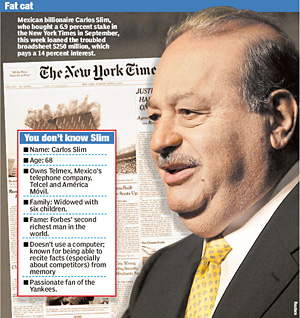
|  |  |  Editorials | Opinions | January 2009 Editorials | Opinions | January 2009  
Times' Mexico Savior the Real Shady Slim
 Paul Tharp - NY Post Paul Tharp - NY Post
go to original

| 
Click image to enlarge | |  |
Eighteen months before Carlos Slim, the controversial Mexican billionaire, decided to ride to the rescue of The New York Times empire, a story on the $60 billion man ran in the Gray Lady.

It called him a "robber baron" and a "crony" of Mexico's notoriously corrupt politicians.

He's now their savior.

Saving the publishing company from the brink of financial ruin - the New York Times Company had $46 million in cash and $1.1 billion in debt as of Sept. 30 - will get you welcomed into a lot of places.

The reclusive, no-frills mogul, however, shrugs off such criticisms. He insists the $250 million in the Times Co. - with a right to boost it to 18 percent of the common shares outstanding - is purely a passive "financial investment."

He will not get a seat on the board and says he is not looking for any influence on the paper.

What The Times is getting is an outspoken investor. Two months ago, Slim told a conference in San Antonio that the US was too soft on bad management and losses. He said the solution to problem companies, particularly on big losers like auto makers, was to push them into Chapter 11 bankruptcy to wipe out overhead and contracts.

Reclusive and harsh, Slim once admonished Microsoft founder Bill Gates and investor Warren Buffet as softies "playing Santa Claus" by giving away their fortunes to help society's ills.

"Poverty isn't solved with donations," he said at a 2007 unveiling of his plan to develop a chain of nursing homes. He said that a tough business style gets more done for society that "going around like Santa Claus."

Slim's example for helping society was building a hospital chain in northern Mexico where the US can ship tens of thousands of Medicare patients for health care that can be delivered cheaper, with fewer expensive regulations.

"Our concept is more to accomplish and solve things, rather than giving," Slim said at the time.

There would be little charity in Slim's rescue of the Times.

He's extracting a stiff 14 percent interest rate on the $250 million investment, and got the Times to agree to strict rules that it couldn't sell assets without his approval.

Slim, who turns 69 this Wednesday, made his fortune buying distressed stocks in Mexico at centavos on the peso during Mexico's deep recession and economic collapse of 1982.

Slim, an engineer by training, got his seed money from a $3 million inheritance from his father, Julian Slim, a Lebanese immigrant who became a successful merchant and real estate investor.

Slim also married into a prominent Lebanese family. His late wife, Soumaya Domit Gemayel, was the niece of former Lebanese President Amin Gemayel. They raised three sons, all of who are key executives in the Slim empire, and three daughters before she passed away in 1999.

Slim's biggest boost, however, came in 1991 through close family ties to Mexico's long-time political leader and former president Carlos Salinas. Both were accused in civil litigation in 1994 of engineering a sweetheart deal in which Salinas sold the state-controlled telephone network, Telmex, to Slim and his investors for just a fraction, or $1.7 billion, of its then $14.5 billion market value. Slim and others denied the allegations. Charges was later dismissed.

Slim and his family avoid the spotlight since a cousin - Alfredo Harp Helu, a banker - was kidnapped and held for three months until the family paid a $30 million ransom for his release.

Slim's critics say he's expanded his riches in a poor country, where the minimum wage is 50 cents an hour, by charging excessively high telephone rates with his near monopoly of Telmex, in which he now owns 67 percent. |

 |
|  |



